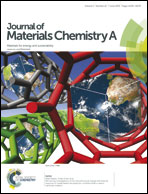Nanostructure formation mechanism and ion diffusion in iron–titanium composite materials with chemical looping redox reactions
Abstract
Iron oxide composites are enabling materials in energy conversion systems including chemical looping and photocatalysis. Extensive earlier experimental findings indicate that inert oxides such as titanium oxide can greatly improve the reactivity of iron oxide over multiple redox cycles. Knowledge on the evolution of the nanoscale morphology of the Fe–Ti materials during the oxidation and reduction is thus of considerable importance. It is also of interest to the fundamental understanding of the ion diffusion mechanism in the reaction processes. In this study, Fe–Ti composite microparticles undergoing cycles of oxidation and reduction are examined at the nano-scale, and the interfacial characteristics of the iron titanium oxides within the composites are probed. Nanobelts are observed to simultaneously form on the microparticle surface during the oxidation at 700 °C, while microblades are found at 900 °C. Additionally, unlike pure iron microparticles that become dense on surface due to sintering effect, Fe–Ti microparticles are transformed into porous particles after redox cycles. The atomistic thermodynamics methods and density functional theory calculations are carried out to investigate the ionic diffusion and vacancy formation during the oxidation and reduction process. A number of surface configurations are considered, and the Ti–Ti–O– terminated surface is computed to the most stable surface structure at experimental conditions. It was found that in oxidation processes, surface Ti atoms are more favorable for oxygen adsorption and dissociation than Fe atoms. The energy barrier of Fe ion diffusion towards the surface, on the other hand, is lower than Ti ion diffusion, which contributes to the Fe2O3-dominant nanobelt formation. The volume change due to high temperature associated with the solid state transformation at the Fe2O3/FeTiO3 interface produces compressive stresses, which stimulate Fe2O3 nanobelt growth to accompany the interface reaction. Also, as the vacancy formation energy of FeTiO3 is lower than Fe2O3 in the reduction process, it indicates that it is easier for a FeTiO3 surface to form vacancy defects, thereby enhancing the porous surface structure formation and O2 diffusivity. The good agreements between experiments and DFT calculations further substantiate nanostructure formation mechanism in redox reactions of iron titanium composite materials.

- This article is part of the themed collection: 2015 Journal of Materials Chemistry A Hot Papers

 Please wait while we load your content...
Please wait while we load your content...